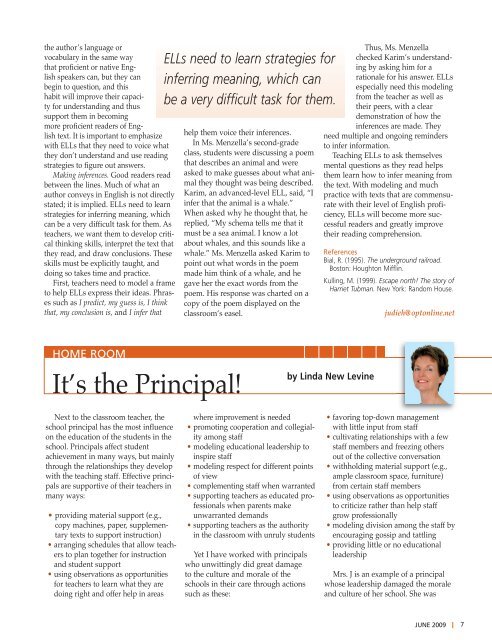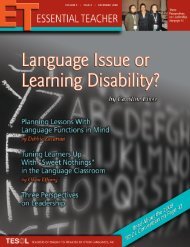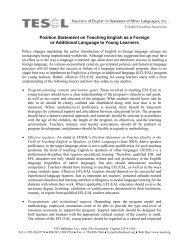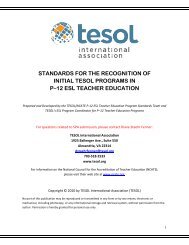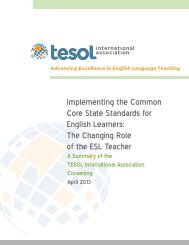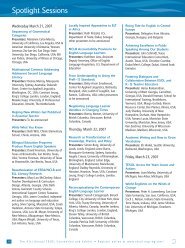Full Issue (PDF) - TESOL
Full Issue (PDF) - TESOL
Full Issue (PDF) - TESOL
Create successful ePaper yourself
Turn your PDF publications into a flip-book with our unique Google optimized e-Paper software.
the author’s language or<br />
vocabulary in the same way<br />
that proficient or native English<br />
speakers can, but they can<br />
begin to question, and this<br />
habit will improve their capacity<br />
for understanding and thus<br />
support them in becoming<br />
more proficient readers of English<br />
text. It is important to emphasize<br />
with ELLs that they need to voice what<br />
they don’t understand and use reading<br />
strategies to figure out answers.<br />
Making inferences. Good readers read<br />
between the lines. Much of what an<br />
author conveys in English is not directly<br />
stated; it is implied. ELLs need to learn<br />
strategies for inferring meaning, which<br />
can be a very difficult task for them. As<br />
teachers, we want them to develop critical<br />
thinking skills, interpret the text that<br />
they read, and draw conclusions. These<br />
skills must be explicitly taught, and<br />
doing so takes time and practice.<br />
First, teachers need to model a frame<br />
to help ELLs express their ideas. Phrases<br />
such as I predict, my guess is, I think<br />
that, my conclusion is, and I infer that<br />
ELLs need to learn strategies for<br />
inferring meaning, which can<br />
be a very difficult task for them.<br />
help them voice their inferences.<br />
In Ms. Menzella’s second-grade<br />
class, students were discussing a poem<br />
that describes an animal and were<br />
asked to make guesses about what animal<br />
they thought was being described.<br />
Karim, an advanced-level ELL, said, “I<br />
infer that the animal is a whale.”<br />
When asked why he thought that, he<br />
replied, “My schema tells me that it<br />
must be a sea animal. I know a lot<br />
about whales, and this sounds like a<br />
whale.” Ms. Menzella asked Karim to<br />
point out what words in the poem<br />
made him think of a whale, and he<br />
gave her the exact words from the<br />
poem. His response was charted on a<br />
copy of the poem displayed on the<br />
classroom’s easel.<br />
Thus, Ms. Menzella<br />
checked Karim’s understanding<br />
by asking him for a<br />
rationale for his answer. ELLs<br />
especially need this modeling<br />
from the teacher as well as<br />
their peers, with a clear<br />
demonstration of how the<br />
inferences are made. They<br />
need multiple and ongoing reminders<br />
to infer information.<br />
Teaching ELLs to ask themselves<br />
mental questions as they read helps<br />
them learn how to infer meaning from<br />
the text. With modeling and much<br />
practice with texts that are commensurate<br />
with their level of English proficiency,<br />
ELLs will become more successful<br />
readers and greatly improve<br />
their reading comprehension.<br />
References<br />
Bial, R. (1995). The underground railroad.<br />
Boston: Houghton Mifflin.<br />
Kulling, M. (1999). Escape north! The story of<br />
Harriet Tubman. New York: Random House.<br />
judieh@optonline.net<br />
HOME ROOM<br />
It’s the Principal!<br />
by Linda New Levine<br />
Next to the classroom teacher, the<br />
school principal has the most influence<br />
on the education of the students in the<br />
school. Principals affect student<br />
achievement in many ways, but mainly<br />
through the relationships they develop<br />
with the teaching staff. Effective principals<br />
are supportive of their teachers in<br />
many ways:<br />
• providing material support (e.g.,<br />
copy machines, paper, supplementary<br />
texts to support instruction)<br />
• arranging schedules that allow teachers<br />
to plan together for instruction<br />
and student support<br />
• using observations as opportunities<br />
for teachers to learn what they are<br />
doing right and offer help in areas<br />
where improvement is needed<br />
• promoting cooperation and collegiality<br />
among staff<br />
• modeling educational leadership to<br />
inspire staff<br />
• modeling respect for different points<br />
of view<br />
• complementing staff when warranted<br />
• supporting teachers as educated professionals<br />
when parents make<br />
unwarranted demands<br />
• supporting teachers as the authority<br />
in the classroom with unruly students<br />
Yet I have worked with principals<br />
who unwittingly did great damage<br />
to the culture and morale of the<br />
schools in their care through actions<br />
such as these:<br />
• favoring top-down management<br />
with little input from staff<br />
• cultivating relationships with a few<br />
staff members and freezing others<br />
out of the collective conversation<br />
• withholding material support (e.g.,<br />
ample classroom space, furniture)<br />
from certain staff members<br />
• using observations as opportunities<br />
to criticize rather than help staff<br />
grow professionally<br />
• modeling division among the staff by<br />
encouraging gossip and tattling<br />
• providing little or no educational<br />
leadership<br />
Mrs. J is an example of a principal<br />
whose leadership damaged the morale<br />
and culture of her school. She was<br />
JUNE 2009 |<br />
7


